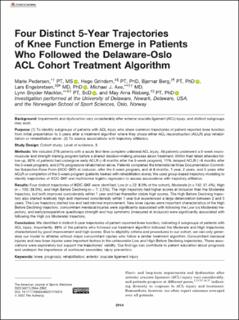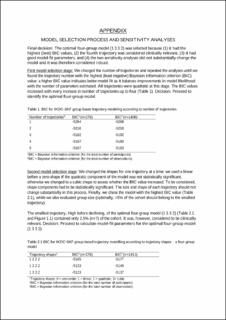| dc.contributor.author | Pedersen, Marie | |
| dc.contributor.author | Grindem, Hege | |
| dc.contributor.author | Berg, Bjørnar | |
| dc.contributor.author | Engebretsen, Lars | |
| dc.contributor.author | Axe, Michael J. | |
| dc.contributor.author | Snyder-Mackler, Lynn | |
| dc.contributor.author | Risberg, May Arna | |
| dc.date.accessioned | 2022-09-14T07:44:06Z | |
| dc.date.available | 2022-09-14T07:44:06Z | |
| dc.date.created | 2022-08-31T11:37:54Z | |
| dc.date.issued | 2022 | |
| dc.identifier.citation | The American Journal of Sports Medicine. 2022, 50(11), Side 2944-2952. | en_US |
| dc.identifier.issn | 0363-5465 | |
| dc.identifier.uri | https://hdl.handle.net/11250/3017701 | |
| dc.description | This article is distributed under the terms of the Creative Commons Attribution-NonCommercial-NoDerivs 4.0 License (https://creativecommons.org/licenses/by-nc-nd/4.0/) which permits non-commercial use, reproduction and distribution of the work as published without adaptation or alteration, without further permission provided the original work is attributed as specified on the SAGE and Open Access page (https://us.sagepub.com/en-us/nam/open-access-at-sage). | en_US |
| dc.description.abstract | Background: Impairments and dysfunction vary considerably after anterior cruciate ligament (ACL) injury, and distinct subgroups may exist.
Purpose: (1) To identify subgroups of patients with ACL injury who share common trajectories of patient-reported knee function from initial presentation to 5 years after a treatment algorithm where they chose either ACL reconstruction (ACLR) plus rehabilitation or rehabilitation alone. (2) To assess associations with trajectory affiliation.
Study Design: Cohort study; Level of evidence, 3.
Methods: We included 276 patients with a acute first-time complete unilateral ACL injury. All patients underwent a 5-week neuromuscular and strength training program before a shared decision-making process about treatment. Within their latest attended follow-up, 62% of patients had undergone early ACLR (<6 months after the 5-week program), 11% delayed ACLR (>6 months after the 5-week program), and 27% progressive rehabilitation alone. Patients completed the International Knee Documentation Committee Subjective Knee Form (IKDC-SKF) at inclusion, after the 5-week program, and at 6 months, 1 year, 2 years, and 5 years after ACLR or completion of the 5-week program (patients treated with rehabilitation alone). We used group-based trajectory modeling to identify trajectories of IKDC-SKF and multinomial logistic regression to assess associations with trajectory affiliation.
Results: Four distinct trajectories of IKDC-SKF were identified: Low (n = 22; 8.0% of the cohort), Moderate (n = 142; 51.4%), High (n = 105; 38.0%), and High Before Declining (n = 7; 2.5%). The High trajectory had higher scores at inclusion than the Moderate trajectory, but both improved considerably within 1 year and had thereafter stable high scores. The High Before Declining trajectory also started relatively high and improved considerably within 1 year but experienced a large deterioration between 2 and 5 years. The Low trajectory started low and had minimal improvement. New knee injuries were important characteristics of the High Before Declining trajectory, concomitant meniscal injuries were significantly associated with following the Low (vs Moderate) trajectory, and early/preoperative quadriceps strength and hop symmetry (measured at inclusion) were significantly associated with following the High (vs Moderate) trajectory.
Conclusion: We identified 4 distinct 5-year trajectories of patient-reported knee function, indicating 4 subgroups of patients with ACL injury. Importantly, 88% of the patients who followed our treatment algorithm followed the Moderate and High trajectories characterized by good improvement and high scores. Due to eligibility criteria and procedures in our cohort, we can only generalize our model to athletes without major concomitant injuries who follow a similar treatment algorithm. Concomitant meniscal injuries and new knee injuries were important factors in the unfavorable Low and High Before Declining trajectories. These associations were exploratory but support the trajectories’ validity. Our findings can contribute to patient education about prognosis and underpin the importance of continued secondary injury prevention. | en_US |
| dc.language.iso | eng | en_US |
| dc.subject | anterior cruciate ligament injury | en_US |
| dc.subject | knee | en_US |
| dc.subject | prognosis | en_US |
| dc.subject | rehabilitation | en_US |
| dc.title | Four distinct 5-year trajectories of knee function emerge in patients who followed the Delaware-Oslo ACL Cohort treatment algorithm | en_US |
| dc.type | Peer reviewed | en_US |
| dc.type | Journal article | en_US |
| dc.description.version | publishedVersion | en_US |
| dc.rights.holder | © 2022 The Author(s) | en_US |
| dc.source.pagenumber | 2944-2952 | en_US |
| dc.source.volume | 50 | en_US |
| dc.source.journal | The American Journal of Sports Medicine | en_US |
| dc.source.issue | 11 | en_US |
| dc.identifier.doi | 10.1177/03635465221116313 | |
| dc.identifier.cristin | 2047528 | |
| dc.description.localcode | Institutt for idrettsmedisinske fag / Department of Sports Medicine | en_US |
| cristin.ispublished | true | |
| cristin.fulltext | original | |
| cristin.qualitycode | 2 | |

